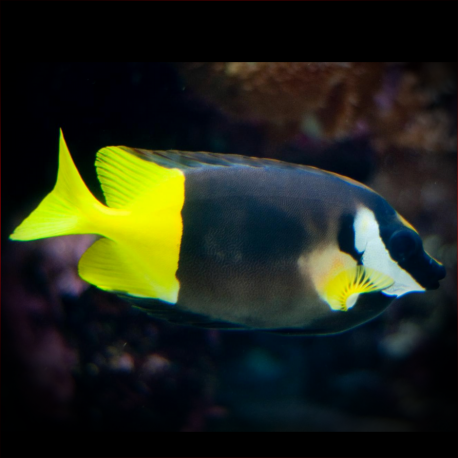More info
Datasheet
| Minimum Tank Size | 800 litres / 211.34 US gallons |
| Maximum Size | 24.0cm / 9.45inches |
| Reef Compatible | Often reef safe |
| Temperament | Mostly peaceful but might be aggressive towards similar species |
| Temperature | 22.2°C / 71.96°F - 25.6°C / 78.08°F |
| Specific Gravity | 1.020-1.025 |
| Carbonate Hardness | 8-12 |
| pH | 8.1-8.4 |
General Description
The Bicolored Foxface, scientifically known as Siganus uspi, belongs to the Siganidae family, which are renowned for their effectiveness in algae control. These fish are native to the Western Pacific, specifically to Fiji, with occasional sightings in New Caledonia. They possess toxic spines on their backs, necessitating cautious handling. When frightened, they have the ability to change color, a behavior associated with their natural camouflage mechanism.
Aquarium Suitability
Considered suitable for most aquarium setups, the Bicolored Foxface requires a minimum tank size of 800 liters due to their swimming habits. These fish are primarily herbivores, with a diet consisting predominantly of algae. It is essential to maintain a well-established aquarium with ample algae growth for their sustenance.
Demands, Care, and Hardiness
The Bicolored Foxface falls under the category of average hardiness, thriving in water conditions with pH levels ranging from 8.1 to 8.4, a temperature range of 22.2-25.6°C, and a specific gravity of 1.020-1.025. They exhibit mostly peaceful temperaments but can display aggression towards similar species if provoked. Ensuring a diet rich in macroalgae and microalgae is crucial for maintaining their health and immune system.
Reef Suitability
While the Bicolored Foxface is often considered reef safe when adequately fed, they may nibble on soft coral and LPS corals if faced with food scarcity. Reef compatibility is amplified when the fish has access to a diversified diet that includes algae-based foods.
Aquarium Setup
To accommodate a Bicolored Foxface, a spacious aquarium with rock formations conducive to algae growth is vital. The presence of hiding spots and a well-maintained algae population on the rocks will allow these fish to exhibit their natural grazing behavior effectively.
Behaviour
These fish have a tendency to swim actively and are known to congregate around rock structures. In response to threats, they can change coloration, often appearing pale or brownish. Understanding their behavior cues can aid in ensuring their comfort and well-being in captivity.
Feeding and Diet
The primary diet of the Bicolored Foxface consists of algae-based foods, including plant-based fish flakes and Nori seaweed. Supplementing their diet with Spirulina and other algae-rich foods is crucial to meet their nutritional requirements.
Dimorphism and Captive Reproduction
Dimorphism and captive reproduction aspects specific to the Bicolored Foxface are not explicitly mentioned in available information.
Habitat and Distribution
Native to Fiji and occasionally sighted in New Caledonia, the Bicolored Foxface inhabits the Central/West Pacific region. These fish thrive in well-established aquariums with thriving algae populations, symbolizing their natural habitat requirements.

